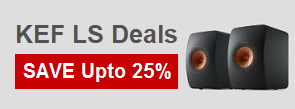Features
| Brand | Musical Fidelity |
|---|
Tech Specs
- Type: Two way, closed type
- Frequency response: 80Hz-20KHz +/-3dB
- Nominal Impedance: 15 Ohms
- Sensitivity: 82.5dB/W/M
- Woofer: 110mm Cone
- Tweeter: 19mm Dome
- Recommended amplifier: 20-150W
- Cabinet: 12mm birch plywood
- Finish: Palisander veneer
- Dimensions: 305 x 190 x 165mm (HxWxD)
- Weight: 4.9Kg (each speaker)
Product Description
Musical Fidelity LS3/5A speakers are based on a classic BBC design from 1976, a two-way stand mount speaker that was designed for studio use and is a great choice for honest sound quality with flat frequency response. An excellent match for the latest version of the Musical Fidelity A1 integrated amplifier, or indeed with any other good amplifier.
They have a very linear frequency response and a closed box design for accurate bass. As a closed box design, the bass goes down to 100Hz. They also have a clean and fast sound with little colouration. Additionally, the mid-range is very detailed and realistic.
LS3/5A was designed as a near field monitor and is best used two to four meters away from the listener, so is well suited to desktop listening set-ups but can be used in normal hi-fi use as well. A very compact speaker with a lot of punch for its size, they’re small enough to accommodate into really any space.
Compact design
The LS3/5A has a 19mm dome tweeter and an 11cm woofer, giving a frequency response from 80Hz-20Khz. The cabinet is made of birch plywood with a Palisander veneer finish.
Notably, the original BBC use of the LS3/5A was for space restricted locations such as mobile control rooms for TV outside broadcasts. However, it also became popular in recording studios, and with audiophiles.
Defined and articulate bass
The LS3/5A rapidly became an industry standard speaker. It is especially good for classical music, with its remarkable low-end information. The bass is defined and articulate. The closed box design has quick bass compared to a ported design.
The 15 Ohm impedance has always made the LS3/5A the perfect partner with class A amplifiers. The power handling is 150 watts and they also work well down to only around 20 watts, making them sell suited to a range of amps.
Why a closed design?
Bass ported enclosures, or bass reflex, came about when amplifier power was low before options like class D were available. Bass reflex speakers are more efficient than closed boxes, and need less amplifier power for a given amount of bass.
A bass port is a tube shaped opening, to the outside air. As a result, the port extends the low-frequency response. However, ports can become non-linear even at relatively low volume. This results in resonances and distortion as well as compression effects. There is also introduced delay and hangover. All of this is not useful in a studio environment, where accuracy is important. Hence the LS3/5A is a closed box design.
What is Class A?
As mentioned, the LS3/5A speakers are good for use with class A amplifiers, like the latest version of the Musical Fidelity A1. Class A amplifiers are less efficient than Class B, and especially so compared with Class D. However, Class A provides the lowest distortion possible. Valve amplifiers are essentially Class A. Class A amplifiers always have current flowing in the output stage - in other words, they are always forward biased.
Whereas, with Class B the output stage does not conduct unless there is a signal. Therefore, a larger power supply is needed for Class A and the output transistors develop a lot of heat. Finally, the 15 Ohm impedance, of the LS3/5A, is also good for class A, as it puts less of a load on the amplifier output.
What are neat field monitors?
Near field monitors usually have smaller drivers. and are used only a few feet away from a listener. That is because they are used on either side of a mixing desk. The sound is more direct, with no room reflections or resonances. As a result, any deficiencies in the sound can be spotted.
The resulting sound also has a flat frequency response and accurate bass. Near field monitors should be placed from two to four feet away from the listener. Toe them in slightly, and isolate them from the desk with rubber pads. Finally, in a domestic environment, they can be used with a subwoofer.
















































































